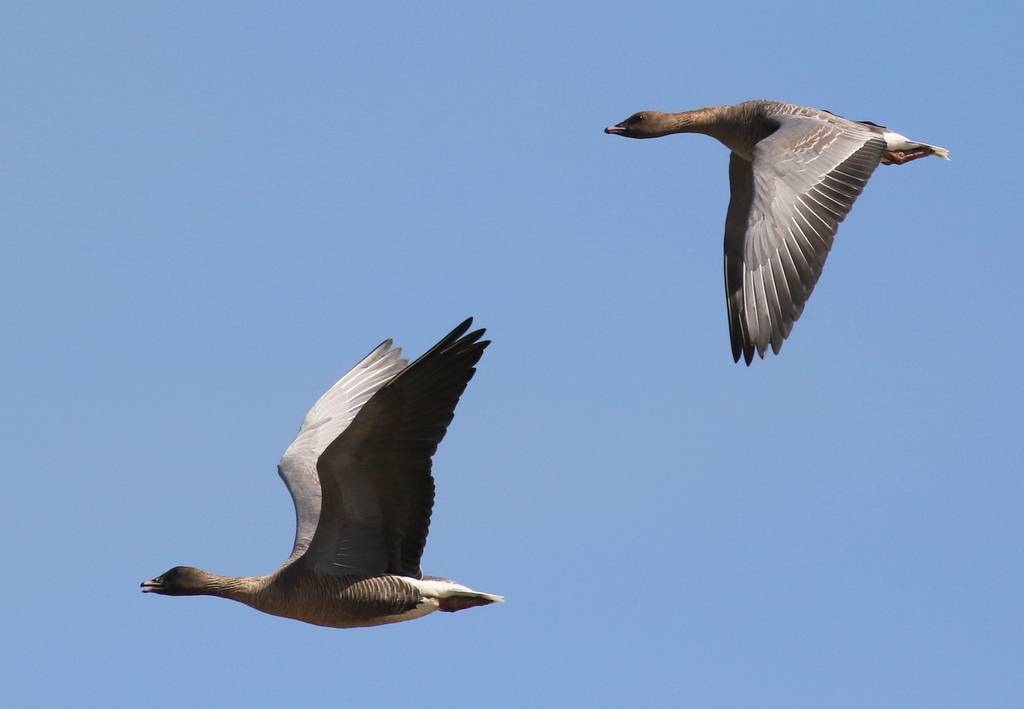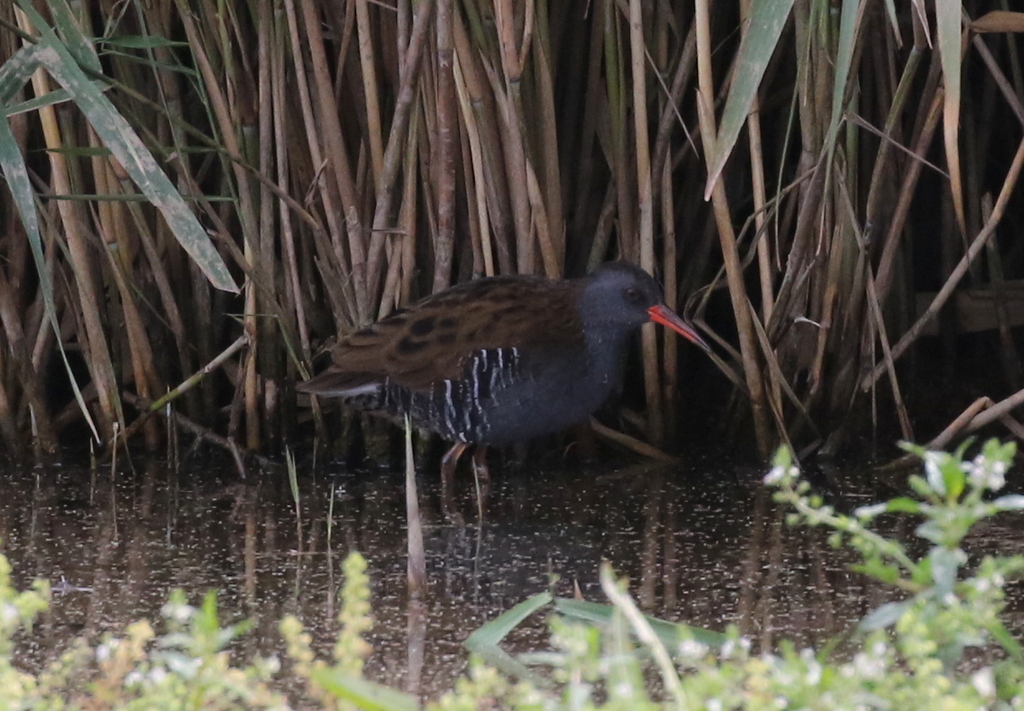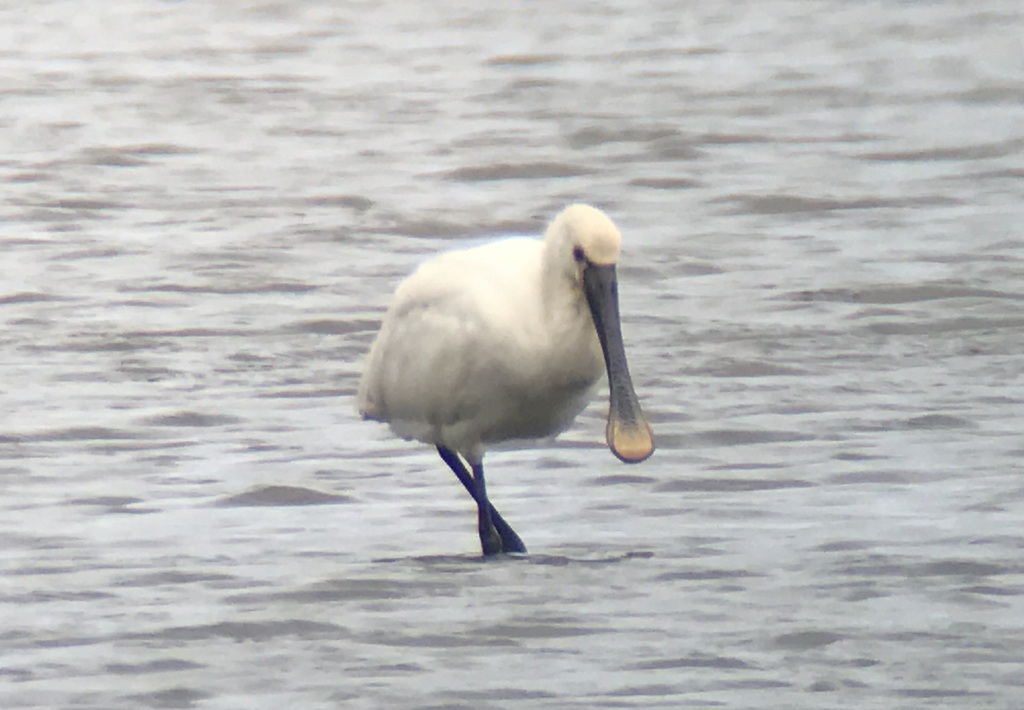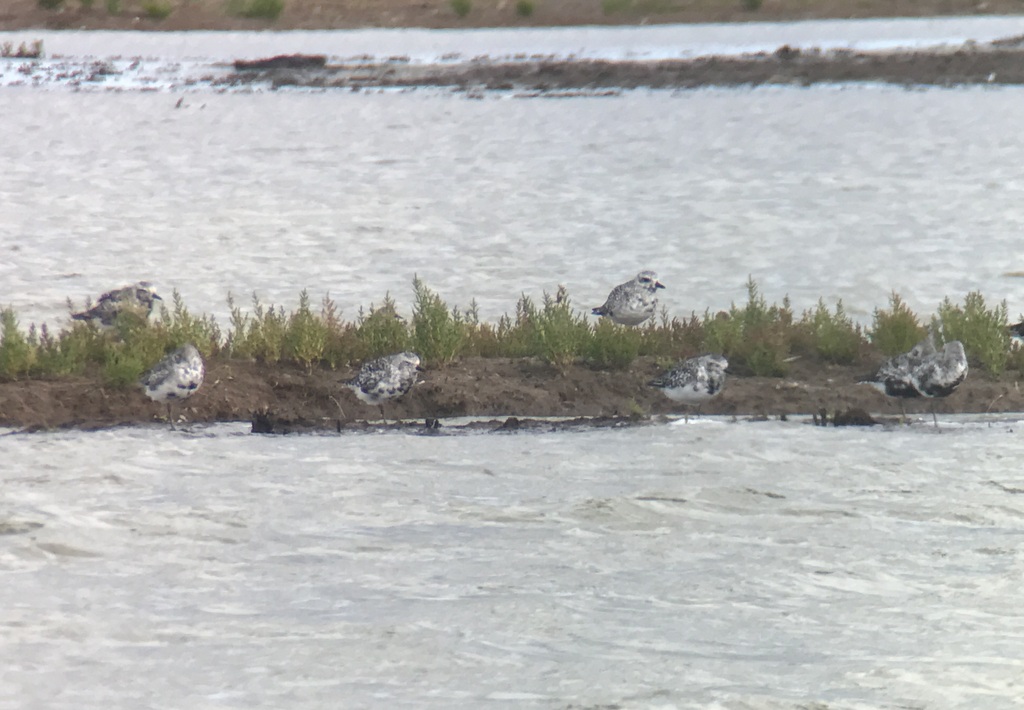Day 2 of a two day Private Tour exploring the North Norfolk coast. It was a nice bright sunny day today, and warm in the afternoon out of the fresh SW wind.
Our first destination this morning was Stiffkey Fen. There were lots of cars overflowing the main bait diggers’ layby this morning, but we found a safe place to pull off the road further down. We made our way very carefully down the road and onto the footpath down by the river.
As we walked through the trees, we could hear tits calling above our heads. It is always worth paying attention to tit flocks at this time as they often have other birds accompanying them, and we looked up to see a Chiffchaff with the Blue Tits, up in the willow leaves. We followed the birds quietly as they made our way ahead of us through the bushes.
As we got out into the open, there were still a couple of House Martins around the house on the hill. A Blackcap flitted up into one of the hawthorns by the path, with a Chiffchaff and a couple of Chaffinches. We could hear a large group of people approaching along the path behind us and, as they overtook us, many of the birds moved off into the trees. We waited for them to get out of earshot, then continued along the path.
A little further along, we found another flock of small birds in the trees just across the river. There were good numbers of Chiffchaffs and Blackcaps in with them today – the former flitting around in the leaves, or flycatching in the sunshine; the latter stopping to feed on the blackberries. We could hear a Lesser Whitethroat calling too, but couldn’t see it from where we were.
Looking over the brambles towards the Fen, we could see a line of Spoonbills roosting in with all the geese. We were looking into the sun from here, so we hurried on to the seawall.

When we got to the seawall, the first thing we saw was a Greenshank down in the harbour channel just beyond. It looked very white below in the sunshine, particularly compared to the Common Redshank feeding on the mud next to it. A Whimbrel walked out from behind the bank further along the channel and a Curlew followed, giving us a great comparison side by side. A Little Egret feeding down in the water in the channel still had fluffy breeding filoplumes on its back although they were rather brown-stained now.
Turning our attention to the Fen, the Spoonbills were mostly asleep on the island, but a small group in the water were busy preening. We could see most of them were juveniles, with flesh-coloured bills, shorter than the adult nearby that had a longer black bill with a yellow tip. We counted twenty two in the group.
There were not many waders out on the Fen today, with the tide already well out in the harbour, but we did find three Pintail roosting in with all the Wigeon and other ducks. A Lesser Whitethroat flew across and landed in an elder bush out in the reeds, where a Reed Bunting was already perched in the top. A Sand Martin flew past along the seawall, on its way west.
As we walked on along the seawall, we stopped to talk to one of the locals walking the other way and another Spoonbill flew in from the harbour and circled in to join the others. The next time we looked back we saw it being chased by a juvenile. The adult Spoonbill flew round and the youngster flew after it. When they landed again, the juvenile walked after it, bobbing its head up and down. When the adult stopped the juvenile started batting it with its wing, begging to be fed. Whatever the adult did, it couldn’t get any peace. This is a common enough sight in the summer, but you would have thought the young Spoonbill might have been old enough to feed for itself by now!
On our way round to the harbour, we stopped to look at a Grey Plover on the mud in the middle of the channel, already in its grey winter plumage. Another Greenshank was roosting on the side of the channel out at the harbour and there were lots of Oystercatchers and Curlew out on the mudflats beyond. We managed to find a couple of Knot too, but the other waders were much further out, with the tide out. When we turned to head back, a juvenile Bar-tailed Godwit had appeared in the channel behind us and we had a good look at it through the scope.
As we walked back towards the seawall, we saw one Common Buzzard drifting west over the back of the Fen and when we got there a second Buzzard was circling over the poplars. A male Marsh Harrier flew in from the saltmarsh and over the Fen, flushing all the Lapwings, which swirled round over the Fen with a flock of Starlings.
We turned to see more Spoonbills coming towards us from the direction of the harbour, thirteen more which flew in and dropped down onto the Fen. A quick look through the scope confirmed there were now at least 36 there. The peak count a couple of weeks ago here was well over 50, and birds have been starting to move off on their way to the south coast for the winter, but it was still an impressive sight, one of the highlights of late summer as the Spoonbills gather here after the breeding season at Holkham.

As we made our way back along the path beside the river, there were several Speckled Wood butterflies out now, basking in the sunshine, and lots of Migrant Hawker and Common Darter dragonflies. We found a Willow Emerald dragonfly too, fluttering around one of the willows, an increasingly common sight along the coast here as they spread rapidly. Another Marsh Harrier, this time a female, was circling over the road as we walked back to the car.
Our next stop was at Wells. As we got out of the minibus, a Marsh Harrier was hunting out over the fields. It was definitely a morning for raptors today, in the sunshine. A Red Kite appeared and flew back and forth over the hedge just beyond the pools, occasionally mobbed by a Jackdaw but just nonchalantly shifting a wing to avoid it. Three Buzzards circled up from the tress on the hill further back and we found another two Red Kites hanging in the air over the fields too.
We scanned the pools on one side of the track, finding a single Green Sandpiper on the mud but not much else. There were a lot more birds on the other side – not least a large mob of hundreds of Greylag Geese. There were some little groups of Egyptian Geese and Canada Geese in with them. The ducks were mainly Wigeon and Teal, with a few Shoveler. We managed to find a couple of Pintail out on the water at the back.
There were lots of Black-tailed Godwits gathered over the far side and several groups of Ruff. As we walked down the track, we found three Common Snipe on the mud on the edge of one of the pools at the far end. The pair of Pink-footed Geese must have been sleeping in the middle of the Greylags because, when two of the latter took off from the throng, the Pink-footed Geese took off with them. They flew across the track just ahead of us, giving us a good view of their dark heads and mostly dark bills, much smaller than the Greylags they were with, and we watched them disappear off west.

A Spoonbill flew across out over the harbour, but dropped down out of view behind the hedge on the hillside ahead of us. Then, as we turned to come back, we got a glimpse of four white shapes fly up and down again in the far corner of the pool. When we walked back a short way, we could see four more Spoonbills here. A Whinchat on the fence on the edge of the field was also a nice bonus – through the scope we could see the pale orange wash on its breast and its pale supercilium.
We had been informed that a couple of interesting moths had been brought in to the moth morning at Cley this morning. A couple of messages confirmed where and when they would be on view and with the help of some of the moth group we were able to get to see them. The Cypress Pug is only the 9th record of the species in Norfolk. It was first recorded in the UK in Cornwall in 1959 having been thought to have been introduced with imported conifers and has since spread along along the south coast.
More impressive but not as rare was the large Convolvulus Hawkmoth. They are migrants from southern Europe and appear here fairly regularly in small numbers at this time of year. Quite a beast and amazing to think that it had managed to migrate all the way here.

We headed over to Titchwell for the afternoon. Over lunch there, we talked a little about migrant moths, and the way rapidly changing populations of some species may be harbingers of a changing climate.
After lunch, we set out to explore the reserve. It was windy once we got out of the trees, but warm in the sunshine. A Cetti’s Warbler seemed to be practicing singing but kept well hidden down in a clump of sallows. The reedbed pool held a few ducks, Common Pochard and Tufted Ducks, as well as three Little Grebes.
It was too windy out in the reeds for the Bearded Tits today, but as soon as we got into the hide we spotted one feeding out on the edge of the mud. We got it in the scope and had a good look at it, a tawny brown juvenile, before it disappeared back into the reeds. Out of the side of the hide, we then noticed a Water Rail working its way along the edge of the water. We got a great view of that too.

There were plenty of waders out on the Freshmarsh this afternoon. A large group of roosting Black-tailed Godwits out in the middle were joined by a flock of Bar-tailed Godwits that flew in from the beach. We could just about see their more contrastingly patterned upperparts, despite the fact that they were facing directly towards us, into the wind. There were three or four Knot roosting in with them too, and two feeding a little further round. A little group of Dunlin was out in the shallow water too.
The water level on the Freshmarsh is very low now, and not helped with the strong SW wind which always blows the water away from the hide the mud in front is getting dry now. The Ruff are feeding further back, on the water’s edge, and the Avocets were mostly over towards the back corner. The juvenile Little Ringed Plover was still with the three Ringed Plovers, but further over between Island and Parrinder hide. Through the scope, we could still see its ghosting of the adult’s yellow eye ring.
As if we hadn’t seen enough Spoonbills already, there were two on the Freshmarsh today. They were roosting on the small brick island at first, but did wake up and walk out into the water, before going back to sleep. Easy life, being a Spoonbill!

We decided to walk out to the beach next. There didn’t seem to be anything over by Parrinder Hide, so we carried on past. There were three Redshanks down in the channel below the West Bank on Volunteer Marsh and a Little Egret on the pool at the corner. Looking down the channel at the far end, we could only find more Redshanks and several Curlews today.
The water level on the non-tidal ‘Tidal Pools’ is very high after the recent high tides. There were just a few waders on the remaining island but they were tucked well into the vegetation – a few Turnstones and a single Grey Plover.
Out at the beach, the tide was coming in and the mussel beds were already covered. All the Oystercatchers were roosting out on the beach today, midway between here and Brancaster. Through the scope we could see a few Bar-tailed Godwits with them. There has been a Purple Sandpiper out here this morning again and with the tide coming in we had hoped that it might be back on the old concrete bunker now. Unfortunately, there were several people walking round it and no birds. We scanned the beach and found a little group of Knot and Redshank.

There was not much out on the sea today, just a very distant Great Crested Grebe, so we set off to walk back. We had seen a flock of Grey Plover fly across behind us while we were on the beach, and we found them now roosting on the ‘Tidal Pools’. They are moulting quickly out of breeding plumage now, and they were variously spotted and speckled with the remains of their black underparts.
As we continued on, we heard a Whimbrel calling behind us and turned to see it flying in over the pool. We whistled a response and it circled round us, but obviously wasn’t too impressed with our impression as it flew on west.

As we got back past the junction to Parrinder Hide, we stopped to have another quick look at the Freshmarsh. There didn’t seem to be anything new dropped in, but we did get a better look at the Bar-tailed Godwits from this angle. A couple were still sporting the remnants of breeding plumage, their rusty underparts looking decidedly patchy now. A Bearded Tit called in the reeds right in front of us but remained tucked down out of the wind.
We could see three or four people looking at the bank by the path a little further along, one down on their knees with a camera. When we got back to them, they showed us a Wasp Spider on its web in the grass. There had been 2-3 along here a couple of weeks ago, but this is the first one we have seen when we have been here. An impressive spider, they are recent colonists from the continent and seem to be spreading quickly now into Norfolk.

We diverted round via Meadow Trail and Fen Trail on the way back. A flock of Long-tailed Tits passed through the trees over our heads as we walked round, but we couldn’t see anything different with them. The bushes round past Fen Trail and along the Tank Road were quiet today, in the wind.
We stopped at the screen overlooking Patsy’s Reedbed. There were lots of ducks on the water – more Common Pochard, Gadwall, Mallard. A single Pintail was preening in amongst one large group of Greylags and a Mute Swan was in with another gaggle. Scanning over the reeds beyond, we spotted a Turtle Dove flying in from the directions of Brancaster Marsh, but it turned and flew across in front of Willow Wood and disappeared behind the bushes.
It was lovely sitting in the sunshine listening to the rustling of the reeds in the wind, but it was time to call it a day now and head back.
















